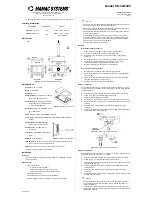
4 Transmitter
25
4.3.2.3.
1-point adjustment by entering a reference value
With the 1-point adjustment you can enter a reference value for a
selected work point (e.g. -40 °C
d
). With this measure you achieve a
minimum deviation between nominal and actual value.
But the further away the measurement is from the working point,
the greater the deviation can become. The 1-point adjustment
should therefore only be used for a relatively narrow measuring
range (working range)
✓
A reference measuring instrument (e.g. chilled mirror dew point
hygrometer) is at hand.
1.
Expose the reference measuring instrument and the testo 6781
to the same, constant conditions and wait until the end of the
automatic initialization phase.
Optimal accuracy is achieved if at least two Self-adjustment
cycles are executed at dew point temperatures higher than
-60 °C
td
, at dew point temperatures below -60 °C
td
four Self-
alignment cycles are recommended.
2.
Measure the reference value and compare it with the
measurement value obtained with the testo 6781.
3.
If the values deviate: Enter the reference value
•
via the operating menu (see Enter reference value for 1-
point adjustment page 37) or
•
via the P2A software (see 1-point adjustment page 66).
Pos: 42 /TD/Erste Schritte/MUF 63xx/Analogausgangs-Abgleich _6781 @ 3\mod_1241426437080_79.doc @ 32365 @ 45 @ 1
4.3.2.4.
Analog output adjustment
The purpose of adjusting the analog outputs is to adjust the signal
chain from the digital signal (within the transmitter) to the analog
outputs. The signal type that was appointed for the transmitter is
adjusted respectively for each channel (e.g. 4 to 20 mA or 0 to 1 V,
etc.).
1
Contact ch. 1+
2.
Contact ch. 1-
3. Service
interface















































